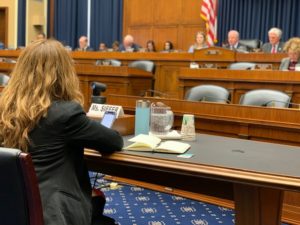 NDIA Executive Director Angela Siefer and representatives of two NDIA affiliates were witnesses at the first-ever Congressional hearing focused on digital equity, held on Wednesday, January 29 by the Communications and Technology Subcommittee of the House Committee on Energy and Commerce. The hearing on “Empowering and Connecting Communities through Digital Equity and Internet Adoption” included testimony by:
NDIA Executive Director Angela Siefer and representatives of two NDIA affiliates were witnesses at the first-ever Congressional hearing focused on digital equity, held on Wednesday, January 29 by the Communications and Technology Subcommittee of the House Committee on Energy and Commerce. The hearing on “Empowering and Connecting Communities through Digital Equity and Internet Adoption” included testimony by:
- NDIA’s Executive Director, Angela Siefer;
- Joshua Edmonds, Director of Digital Inclusion for the City of Detroit, MI;
- Gigi Sohn, Distinguished Fellow at Georgetown Law Institute for Technology Law and Policy;
- Jeffrey R. Sural, Director, at the Broadband Infrastructure Office, North Carolina Department of Information Technology, and;
- Roslyn Layton Visiting Scholar at the American Enterprise Institute.
The City of Detroit and the NC Broadband Infrastructure Office are NDIA affiliates.
Members of the Subcommittee, led by Pittsburgh Rep. Michael Doyle, heard witness testimony debunking popular myths and misconceptions, including the myth that filling the gaps in rural broadband infrastructure in the United States will, by itself, “bridge the digital divide”. As NDIA’s Siefer pointed out:
“…about fourteen million urban households (in major metro areas as well as smaller cities and towns) and 4 million rural households, still lacked broadband subscriptions of any kind, including mobile data plans. What did 60% of unconnected urban residents have in common with more than half of the unconnected rural households? They all had household incomes below $35,000. Households with incomes less than $35,000 make up 28% of all U.S. households but they account for 60% of those without any broadband internet service.
We do need to address the lack of broadband infrastructure in rural areas. It is a serious problem. But, it is just one barrier to individuals and communities being able to fully participate in society today. The other common barriers, no matter where one lives, are the costs of internet service and devices, plus digital literacy skills. Simplistically equating “the digital divide” with just one of these barriers increases the division in our country.”
Director Edmonds commented:
“This past holiday season, when working with Los Angeles based social enterprise, human I-T, and the Detroit Housing Commission, we were able to provide 75 families with free computers. I made one phone call to Comcast, and they agreed to provide 75 families six months of free internet access through their Internet Essentials program.
These are examples of how local leadership has called on industry to fill in where the federal government is silent. In Detroit, we have developed public-private partnerships without any government funding, but it is an unsustainable model. We need federal resources to continue our work. If we were to receive additional funding, we could do more robust outreach, and incentivize more localized funding from philanthropic organizations.”
Director Sural reiterated research about the challenges of cost:
“Subscription cost is the main barrier to adoption among households with access. In 2015, the Pew Research Center found that subscription costs are the primary barrier to adoption for 33 percent of non-adopting households nationwide. This is especially true among low-income households. As mentioned earlier, North Carolina’s high-income households are more than twice as likely to adopt broadband than low-income households. A lack of access to a digital device—such as a laptop, tablet or computer also discourages broadband adoption. The 726,000 North Carolinian households who don’t currently have a digital device are unlikely to subscribe to an internet service.”
Complete copies of these and other witness statements are available via the Subcommittee’s web page for the hearing.
